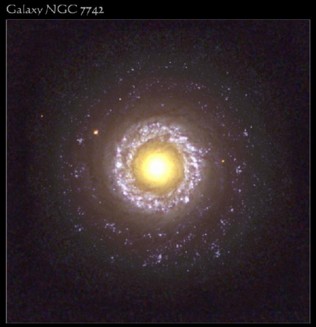
A galaxy is any of the billions of systems of stars and interstellar matter that make up the Cosmos.
Galaxies vary considerably in size, composition, and structure, but nearly all of them are arranged in groups, or clusters, of from a few to as many as 10,000 members each. The diameters of galaxies are generally measured in tens of thousands of light-years. The distance between galaxies within a cluster averages approximately 1,000,000-2,000,000 light-years, and the spaces between clusters of galaxies may be a hundred times as great. Each galaxy is composed of innumerable stars--most likely from hundreds of million to more than a trillion stars. In many galaxies, as in the Milky Way Galaxy, clouds of interstellar gas and dust particles known as nebulas can be detected.

The majority of known galaxies fall into one of three major classes: spirals, ellipticals and irregulars. Roughly 70 percent of the bright galaxies in the sky are of the spiral variety, including the Milky Way Galaxy.
A spiral galaxy has a main disk of stars 50,000 to 150,000 light-years in diameter and a thickness up to a tenth as great. Embedded in the disk are the spiral arms, winding out from the centre like those of a pinwheel. The arms contain the greatest concentration of a spiral galaxy's interstellar gas and dust, and it is in these regions that star formation can occur. Among newly formed stars are the occasional short-lived, highly luminous ones; their presence in the arms makes them conspicuous on telescopic photographs. Surrounding the central nucleus of a spiral galaxy is a large nuclear bulge, which is nearly spherical in most cases and may have a diameter of up to half that of the disk. Outside the nuclear bulge and disk is a sparse, more or less spherical halo of star clusters, individual stars, and perhaps other matter. The halo may extend far beyond the disk and contain most of the galaxy's mass.
Spiral galaxies are generally subdivided into "normal" and "barred" types. In the latter, the arms begin either from the ends of a straight bar of stars and interstellar matter passing through the nucleus or from a circular ring surrounding the bar, rather than from the nucleus. Spirals are still further subdivided according to three well-correlated parameters: the size of the nucleus, the tightness of the winding of the arms, and the smoothness of the arms.
An elliptical galaxy has a telescopic image that reveals a symmetrical distribution of stars in a spherical or spheroidal shape. Such galaxies range from the rare giant ellipticals, which extend several hundred thousand light-years across, to dwarf ellipticals of only a few million stars. The dwarf ellipticals are by far the most common kind of galaxy, although none is conspicuous in the sky. The projected images of ellipticals range from nearly circular to extremely elongated. Their flattening, however, is not due to rotation, and it is not known whether their true shapes are oblate or prolate spheres.
A small number of galaxies do not fit neatly into the usual scheme, and they are classified as irregular. There are also some special classes, a few of which are considered here. The first of these are the S0 galaxies, which are usually found in rich clusters of galaxies. They resemble spirals but have no spiral arms, possibly because their interstellar matter is stripped away as they move through intracluster gas. A second type of unusual star system is the cD galaxy. Such galaxies are supergiant ellipticals that often occur at or near the centre of rich galactic clusters. They are thought to result from the merging, or fusion, of several galaxies that have collided. Active nuclei galaxies constitute one other notable class of unusual galaxies. Their central nuclei show evidence of spectacular or violent activity. These range from Seyfert galaxies to quasars, the latter generally believed to be exceedingly bright nuclei of very remote galaxies.
Excerpt from the Encyclopedia Britannica without permission.